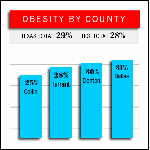Ten years ago, the percentage of people considered clinically obese was under 20 percent in 28 states. That is the case now in only one state: Colorado. Moreover, in nine states, more than 30 percent of the residents are now obese.
 The Centers for Disease Control, which now reports the nation’s obesity rate at 28 percent, indicated that it’s probably much higher, because people often underestimate or understate their weight in surveys. A previous CDC study based on actual measurements of height and weight found that almost 34 percent of Americans were obese.
The Centers for Disease Control, which now reports the nation’s obesity rate at 28 percent, indicated that it’s probably much higher, because people often underestimate or understate their weight in surveys. A previous CDC study based on actual measurements of height and weight found that almost 34 percent of Americans were obese.
Obesity is based on a body-mass index (BMI) determined by height and weight. A BMI above 30—or about 210 pounds for a 5-foot, 10-inch person—is what places a person in this category. A BMI of 18.5 to 24.9 is considered a healthy weight, and 25-29.9 is considered overweight. (Click here for the National Institutes of Health’s online BMI calculator.)
Obesity is a factor in several causes of death, including stroke, diabetes and heart disease. Obese people have average annual medical costs of $1,429 more than healthy-weight people do. Obesity is the fastest-growing public-health issue the U.S. has ever faced. It’s expected to account for more than 20 percent of healthcare spending by 2018.
Locally, residents in Collin County are the most fit, with a 25 percent obesity rate. Tarrant is next, at 28 percent, the country’s average. Residents in Denton (30 percent) and Dallas (31 percent) counties are the heftiest.
Note: See D Healthcare Daily’s report on updated Texas obesity numbers here.






